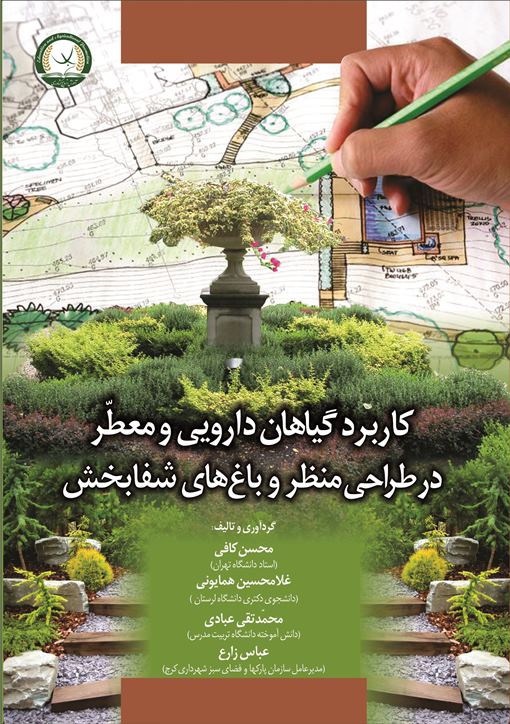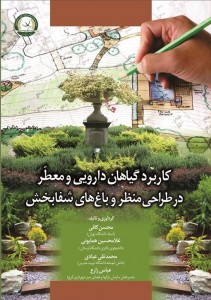Publication of the Book, “Application of Medicinal and Aromatic Plants in Landscape Design and Healing Gardens”

The book “Application of Medicinal and Aromatic Plants in Landscape Design and Healing Gardens”, was published coincidentally with Tehran’s Twenty-eighth International Book Fair (April, 2015).
The book “Application of Medicinal and Aromatic Plants in Landscape Design and Healing Gardens”, was published coincidentally with Tehran’s Twenty-eighth International Book Fair (April, 2015).
Application of Medicinal and Aromatic Plants in Landscape Design and Healing Gardens
Written and Compiled by: Mohsen Kafi, Gholam Hossein Homayouni, Mohammad Taghi Ebadi, Abbas Zare
Published by: Education and Promotion of Agriculture Publication (Entesharat Amoozesh va Tarvij Keshavarzi)
First published 2015
1st Printing
International Standard Book Number: 9786006362953
Pages: 384
In the introduction of this book we have: ever since the beginning of creation, human beings have been in touch with their surrounding nature. Nature has been respected by different races in the world since it has been considered as God’s creation. In the myths and legends of the existence of the universe, there is the description of creation in areas and locations near the natural elements such as rivers, mountains, swamps, etc, which represents the relationship between God created elements and natural environment. As if, the nature of human has been tempered with nature itself, and this relationship is part of its needs. Unfortunately, due to so many factors such as the modern lifestyle, in the present century this relationship has been lost in the midst of the hectic urban life and keeps deteriorating.
The industrialization of the urban life has made unpleasant physical and spiritual modifications on urban human beings and has severely damaged their physical and psychological physiology, which has mostly been caused by the detachment of todays man from the natural environment and its existing elements. Therefore, there is no other way but to establish a balanced relationship between nature and technology or in other words, modern life. Parks of different sizes are considered as green patches of ecological and social centers of life in cities. The existence of various plant species and trees in these areas can reconcile man and nature in cities. The healing gardens phenomenon is a new subject that is currently widely acknowledged throughout the world. Owing to the deep connection between the five senses and nature and the intrinsic properties of therapeutic gardens, they are distinctive from other gardens and certain specific usages are defined for them. Observing the designing principles and choosing the appropriate species, will make it possible for the healing gardens to eliminate the physical and spiritual problems with the assistance of the powerful effect of nature on mankind. The goal of this book is to depict the application of medicinal plants in making of gardens and designing landscapes, hence the establishment of healing gardens in cities. Now, with the support of God, by publishing this book, the initial steps into establishing conceptual and scientific connection between urban landscapes and medicinal plants are taken, all these in order to develop healing gardens in the cities of our country. With the assistance of the compilers, their scientific knowledge and administrative experience in this regard, we can pay tribute to the valuable history and culture of our great country.
Mohsen Kafi
(Professor of Tehran University, horticulture and landscape science and engineering department)
Gholam Hossein Homayouni
(Lorestan University PhD student of horticulture science)
Mohammad Taghi Ebadi
(Holder of medicinal plant PhD degree from Tehran Tarbiat Modares University)
Abbas Zare
(Managing director of Parks and Landscape Organization of Karaj Municipality)
Contents
Authors acknowledgment
Preface
Modern outlook on position of medicinal plants in landscapes and healing gardens
Healing gardens, common era of landscapes, Iranian traditional gardens and medicinal plants
Medicinal plants, an embracement of making gardens and Iranian nature in creating xeriscaping
Healing and healing garden properties
Healing garden indexes
Some ground cover plants substituted by medicinal plants
Medicinal plants as reducers of surface evapotranspiration
Medicinal plants and consistent development of urban landscapes
Medicinal plants as an important device in weight distribution of water in xeriscaping
Medicinal plants and the increase of water efficiency
Medicinal plants and the development of shading mechanism in landscapes
Medicinal plants application similar to edible gardens
Revival of traditional medicine
Last word
First chapter: Application of medicinal plants’ potentials in landscapes
The importance and the advantages of medicinal plants usage in landscapes
The significant and notable qualities to consider when choosing a medicinal plant for application in landscape design
The psychology of colors in green space with reliance on medicinal plants
The introduction
Color-designing principles
Chapter two: Classification of plants used in landscapes
Classification of plants based on botany
Classification of landscape plants from the viewpoint of resistance to environment conditions
Classification of landscape plants based on their growth habits and shape and type of aerial stems
Classification of landscape plants based on their life cycle
A: Annual landscape plants
B: Biennial landscape plants
The application of annuals and biennials in landscape design
1- Annuals
A: Sustainable annuals
B: Sensitive annuals
2- Biennials
C: Landscape perennials
Perennial herbaceous application in landscape planting design
Classification of suitable medicinal plants for application in landscape design
Chapter three: Environmental criteria in choosing a plant species
Introduction
Chemical air pollution control
Physical air polluion control
Resistance against sulfur dioxide
Release of oxygen
Sunshine and temperature control (shade of tree)
Wind or air current control
Rain and humidity control
Soil erosion and fixation control
Water erosion control
Chapter four: The physical criteria in choosing a plant species
Introduction
Plant growth habits
Trees and shrubs sizes
The need to have a suitable ecology with the climatic conditions of the area
Prevention of planting polluting trees
Prevention of eating some plants
Problems and limitations of plant species
Price and accessibility of species
No allergy-causing
Hedge plants
Ground cover plants
Advantages of ground cover plants
Designing with ground cover plants
Plant tissue
Color and ornamental display in different seasons
Color and ornamental display in winter
Shape of the leaf
Unwanted flower bulbs
Chapter five: Designing criteria in choosing species
Introduction
Habitat and the kind of area where the plant is chosen for
Visual motion control (engird and encompass private areas, control and lead the view)
Annoying reflective rays control
Measurement
Ground and context
Complex
Variety and peace
Sequence
Identity
Sign
Symbol
Unity
Style
A: Formal style
B: Informal style
Chapter six: The introduction of medicinal and aromatic plants, applicable in landscapes
1- Calotropis procera
2- Lavandula officinalis
3- Eucalyptus globulus
4- Sambucus nigra
5- Thymus spp
T.vulgaris
T.citriodorus
T.daenensis
6- Matricaria chamomilla
7- Anthemis nobilis
8- Melissa officinalis
9- Laurus nobilis
10- Quercus spp
11- Viola odorata
12- Achillea millefolium
13- Lippia citriodora
14- Salix alba
15- Salix aegyptiaca
16- Cathrantus roseus
17- Vitex agnus-castus
18- Pyracantha spp
19- Tamarindus indica
20- Betula pendula
21- Ginkgo biloba
22- Stachys lavandulifolia
23- Melia indica
24- Ilex aquifolium
25- Althaea officinalis
26- Rosmarinus officinalis
27- Berberis vulgaris
28- Cornus mas
29- Hyssopus officinalis
30- Olea europaea
31- Melia azedarach
32- Santolina chamaecyparissus
33- Echinacea spp
34- Taxus baccata
35- Rhus coriaria
36- Elaeagnus angustifolia
37- Cordia myxa
38- Papaver rhoeas
39- Pelargonium graveolens
40- Cotoneaster frigidus
41- Tanacetum vulgare
42- Physalis alkekengi
43- Solidago virgaurea
44- Cymbopogon citratus
45- Ziziphus jujuba
46- Linum usitatissimum
47- Ricinus communis
48- Ziziphus spina-christi
49- Capparis spinosa
50- Gypsophila paniculata
51- Digitalis purpurea
52- Chrysanthemum cinerariaefolium
53– Hypericum perforatum
54- Passiflora incarnata
55- Gentiana lutea
56- Saponaria officinalis
57- Echium amoenum
58- Centaurea cyanus
59- Verbascum thapsus
60- Rosa damascena
61- Oenothera biennis
62- Agastache foeniculum
63- Silybum marianum
64- Origanum vulgara
65- Salvia officinalis
66- Myrtus communis
67- Rosa canina
68- .Tilia spp
69- .Crataegus spp
70- Calendula officinalis
Chapter seven: Types of healing gardens
Introduction
Section one: Digestive system garden
1- Antioxidant medicinal plants
2- Decrease appetite medicinal plants
3- Stimulate appetite medicinal plants
4- Constipation treatment medicinal plants
5- Diarrhea treatment medicinal plants
6- GERD treatment medicinal plants
7- Food digestion medicinal plants
8- Flatulence and cramping treatment medicinal plants
Section two: Skeletal system gardens
1- Arthritis
2- Back pain
3- Torn cartilage
4- Muscle joint pains
5- Muscle spasm
6- Strains
Section three : Immune system gardens
1- Allergies
2- Common cold
3- Wet cough
4- Dry cough
5- Hay fever
6- Flu
7- Sore throat
Section four : Integumentary system gardens
1- Acne
2- Athlete’s foot disease
3- Bites/stings
4- Bruises
5- burn
6- Minor cuts and scrapes
7- Eczema
8- Psoriasis
Section five: Nervous system garden
1- Anger tonic
2- Anxiety
3- Depression
4- Insomnia
5- Memory
6- Tension headaches
7- Migraine
8- Stress
Chapter six: Circulatory systems gardens
1- Antioxidant
2- Arteriosclerosis
3- Blood lymph cleanser
4- Hemorrhoids
5- High blood pressure
6- High cholesterol
7- Varicose veins
References
Glossary
- Comments submitted by you will be published by administrators after approval.
- Comments that contain mohareb or worse will not be published.
- Comments that will not be published other than English or non-English.


Send Comment
Total comments : 0 Pending review : 0 Published : 0